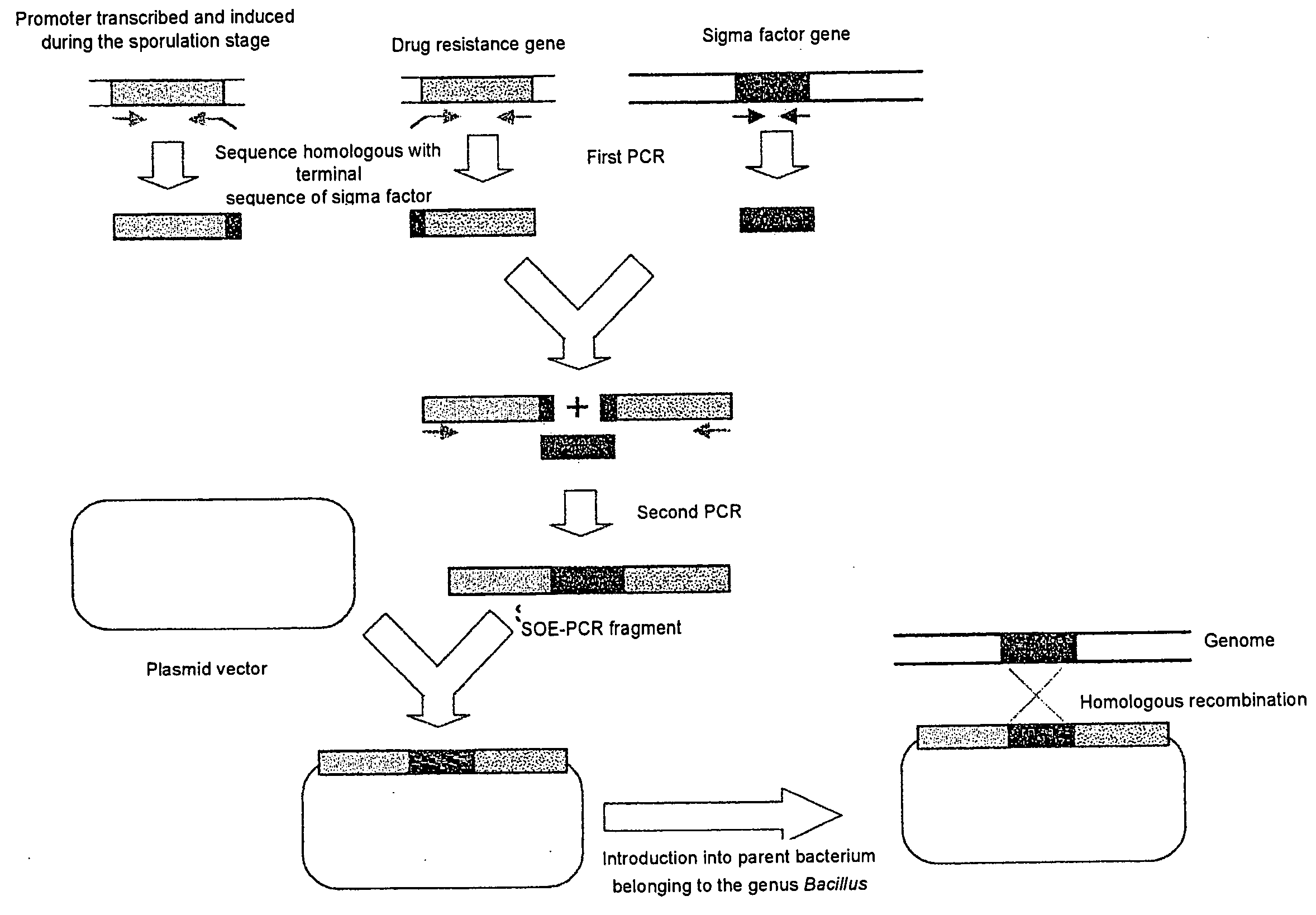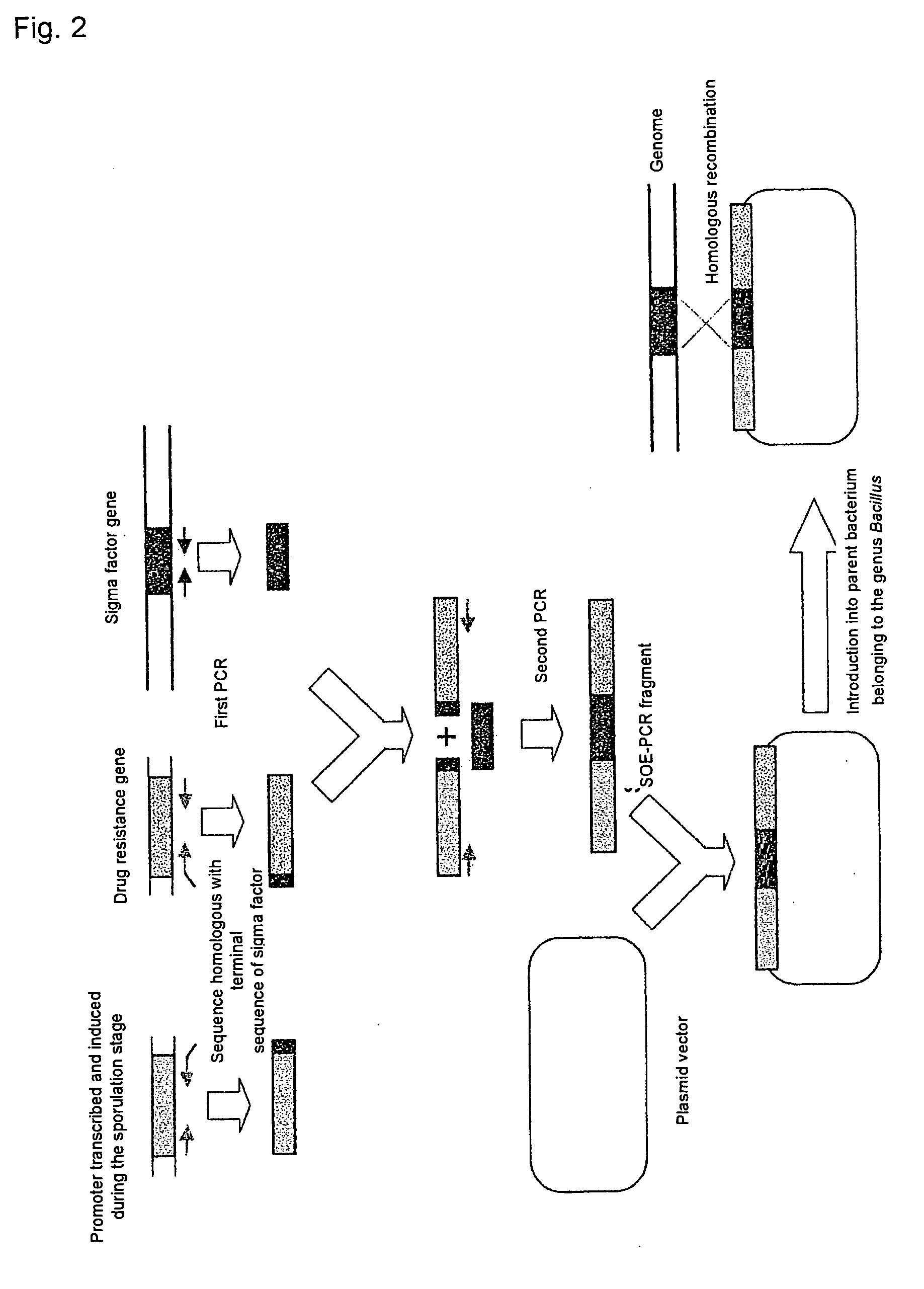Mutant bacterium belonging to the genus bacillus
a bacterium and genus technology, applied in the field of recombinant microorganisms and host microorganisms, can solve problems such as the production of useful bacteria
- Summary
- Abstract
- Description
- Claims
- Application Information
AI Technical Summary
Problems solved by technology
Method used
Image
Examples
example 1
Construction of Plasmid Employed in Introducing into the Genome of Bacillus subtilis, a Siga Gene Containing Promoter Transcribed Specifically During the Sporulation Stage
[0071]Construction of a plasmid was performed. The plasmid was employed in introducing a DNA fragment having a promoter for expressing a sigH gene or a promoter for expressing a spoIIA operon ligated to an upstream end of a sigA structural gene into the genome of Bacillus subtilis through single crossing over homologous recombination in accordance with the procedure as shown in FIG. 2. Specifically, a genome DNA sample, serving as a template, extracted from Bacillus subtilis 168 and a primer set of sigAf and sigAr shown in Table 8 were employed, to thereby prepare a 1.2 kb fragment (A) having a sigA gene through PCR. In the same manner above, a primer set of sigHUf and sigHUr-sigA shown in Table 8 was employed, to thereby prepare a 1.0 kb fragment (B) containing a sigH gene promoter flanking the upstream side of th...
example 2
Introduction of the sigA Gene Containing Promoter Transcribed Specifically During the Sporulation Stage Into the Genome of Bacillus subtilis 168
[0073]Bacillus subtilis 168 was transformed through the competent method with the plasmid pMWPHsigA, pMWPFsigA, or pMWPFsigAm. The plasmids pMWPHsigA and pMWPFsigA were employed for introducing, into the genome of Bacillus subtilis, the sigA gene containing the promoter transcribed specifically during the sporulation stage. The plasmid pMWPFsigAm was employed for introducing, into the genome of Bacillus subtilis, a modified sigA gene (sigAm) containing the same promoter, in which an initiation codon (ATG) of the sigA gene had been substituted by a codon (ATA). Colonies grown in an LB agar medium containing chloramphenicol were collected as transformants. Subsequently, the genome of the each transformant produced by use of pMWPHsigA or pMWPFsigA, serving as a template, was extracted, and PCR was performed thereon, to thereby confirm that the ...
example 3
Evaluation of Bacillus subtilis Mutant Strain in Terms of Alkaline Cellulase Production (Secretion) Performance
[0074]To each of the three types of Bacillus subtilis mutant strains obtained in Example 2 (168PHsigA, 168 PFsigA, and 168 PFsigAm) and to Bacillus subtilis 168 serving as a control, a recombinant plasmid pHY-S237 was introduced through the protoplast transformation method. The recombinant plasmid pHY-S237 was prepared by inserting a DNA fragment (3.1 kb) encoding an alkaline cellulase (JP-A-2000-210081) derived from Bacillus sp. KSM-S237 (FERM BP-7875) into the restriction enzyme BamHI cleavage site of a shuttle vector pHY300PLK (yakult) The cells were shake-cultured in LB medium (10 mL) overnight at 37° C. The culture broth (0.05 mL) was inoculated to a 2×L-maltose medium (50 mL) (2% tryptone, 1% yeast extract, 1% NaCl, 7.5% maltose, 7.5 ppm manganese sulfate 4-5 hydrate, and 15 ppm tetracycline), followed by shake-culturing at 30° C. for three days. After completion of c...
PUM
| Property | Measurement | Unit |
|---|---|---|
| Fraction | aaaaa | aaaaa |
| Fraction | aaaaa | aaaaa |
| Alkalinity | aaaaa | aaaaa |
Abstract
Description
Claims
Application Information
 Login to View More
Login to View More - R&D
- Intellectual Property
- Life Sciences
- Materials
- Tech Scout
- Unparalleled Data Quality
- Higher Quality Content
- 60% Fewer Hallucinations
Browse by: Latest US Patents, China's latest patents, Technical Efficacy Thesaurus, Application Domain, Technology Topic, Popular Technical Reports.
© 2025 PatSnap. All rights reserved.Legal|Privacy policy|Modern Slavery Act Transparency Statement|Sitemap|About US| Contact US: help@patsnap.com



